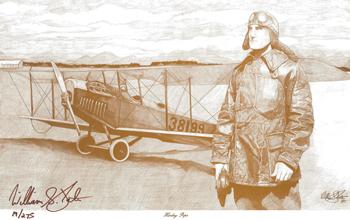 One hundred years ago, the flying field at Camp Bragg was officially established by the War Department and renamed in honor of 1st Lt. Harley Halbert Pope, commander of the 276th Aero Squadron. On Jan. 7, 1919, Pope and Sgt. Walter Fleming were flying a JN-4 “Jenny” biplane from Camp Jackson, South Carolina, to Camp Bragg when they ran out of fuel and attempted a landing on the Cape Fear River near Fayetteville. Both Pope and Fleming were killed in the crash.
One hundred years ago, the flying field at Camp Bragg was officially established by the War Department and renamed in honor of 1st Lt. Harley Halbert Pope, commander of the 276th Aero Squadron. On Jan. 7, 1919, Pope and Sgt. Walter Fleming were flying a JN-4 “Jenny” biplane from Camp Jackson, South Carolina, to Camp Bragg when they ran out of fuel and attempted a landing on the Cape Fear River near Fayetteville. Both Pope and Fleming were killed in the crash.
The year Pope Field was established was a busy period for the new military post. In March 1919, Cumberland County and Camp Bragg made an agreement to fund and maintain a road between Fayetteville and the post. In May 1919, a Memorial Day Pageant was held to welcome home soldiers from the first World War and to celebrate the near completion of Camp Bragg. In November, Armistice Day was declared a legal holiday and celebrated in Fayetteville and at Camp Bragg.
General of the Armies John J. Pershing, who served as the commander in chief of the American Expeditionary Forces, visited the newly established Camp Bragg and Pope Field in December 1919. By the end of 1919, Congress passed a bill appropriating funds to ensure the development of Camp Bragg, to include construction of an airplane hangar at Pope Field. Initially, balloons and singleengine biplanes were stationed at Pope. Their missions included terrain mapping and spotting for artillery and forest fires as well as carrying the mail.
Pilots landing at Pope were required to buzz the area from low altitude to chase off grazing deer. The biplanes from Pope Field became a familiar sight in the skies over Fayetteville.
The earliest known aerial photograph of Fayetteville was taken in 1919 over Market Square from the cockpit of a plane from Pope Field.
When Pope Field was established in 1919, aviators were assigned to the U.S. Army Air Service. In 1920, the Air Service became a branch of the Army, and in 1926 it was renamed the Army Air Corps.
From 1919 to 1927, Pope Field was used for observation balloon training. In 1927, Maj. Carl Spaatz conducted bombing training there, and in 1929, the base was used for joint air-ground training. By 1940, the runways were paved.
In 1941, the aviation branch was renamed the U.S. Army Air Forces. During World War II and afterward, Pope was used for training crews in airborne and resupply missions. It continued to exist as a branch of the Army until reorganization provisions of the National Security Act of 1947 created a separate Department of the Air Force and the United States Air Force.
In 1947, Pope Field became a separate Air Force Base. The first fighter unit was stationed at Pope in 1954. In 1970, the base was modified to accept the heavy transport plane C-5A. Personnel and aircraft from Pope have been involved in humanitarian and directed combat actions.
In 2011, Pope Air Force Base was absorbed into Fort Bragg, becoming an Army-operated facility supporting Air Force operations and merging the post’s growing Army and joint force community.
For more information on the history of Pope Field, visit the exhibits located at the Fayetteville Transportation and Local History Museum, 325 Franklin St., and the lobby of City Hall, 433 Hay St. The Transportation and Local History Museum features artifact and image-filled exhibits focused on Fayetteville and Cumberland County’s history. Admission is free.
The museum staff will present a program about the history of Pope Field Thursday, July 1, at 6:30 p.m. in the State and Local History Room at the Headquarters Library on Maiden Lane.
Photo: 1st Lt. Harley Halbert Pope

 How to resolve AdBlock issue?
How to resolve AdBlock issue? 








